Featured
Of mental health and guns
July 18, 2013
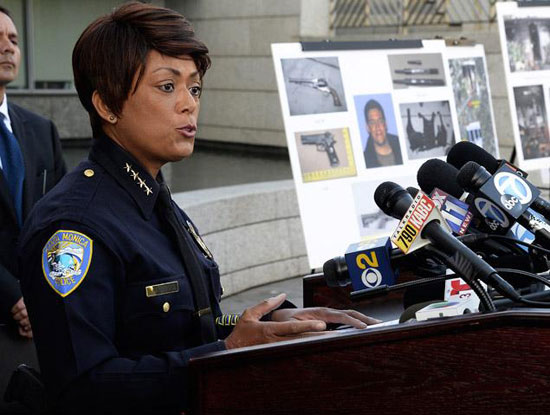
Santa Monica Police Chief Jacqueline Seabrook discusses the shooting rampage of John Zawahri last month.
By now, the scenario is tragically, infuriatingly familiar; a young man with a history of mental illness unleashes a burst of bullets from a high-capacity weapon, stealing lives and shattering communities in a matter of minutes.
The latest rampage erupted last month in Santa Monica. In a span of just 13 minutes, 23-year-old John Zawahri killed five people—including his father and brother—and terrorized countless others on a shooting spree that ended inside the Santa Monica College library, where police gunned him down.
Zawahri was armed with an assault rifle that authorities suspect may have been assembled from parts bought on the Internet, sidestepping California’s ban on such arms. He also was carrying a .44-caliber handgun and more than 1,300 rounds of ammunition. In the days after the shooting, it was disclosed that Zawahri had been admitted to the psychiatric ward of UCLA Medical Center in 2006 after a teacher at his high school discovered the teenager researching assault weapons online.
The Santa Monica slayings have renewed calls for stricter gun and ammunition controls, both of which I’ve long championed while serving on the Board of Supervisors and on the Los Angeles City Council. But the time is well upon us to also confront serious shortcomings in our mental health system—and in the antiquated attitudes too many of us harbor towards treatment—if we’re ever to succeed in curbing the carnage.
Earlier this week, Rep. Henry A. Waxman convened a forum in Santa Monica on “gun violence, mental health and community recovery.” I was honored to have been asked to participate, alongside an impressive panel of federal, state and local representatives. I was especially encouraged by Rep. Waxman’s announcement that he was pursuing legislation that takes aim not only at loopholes in federal gun laws but also at strengthening, in his words, the nation’s mental health infrastructure.
No doubt, the congressman’s efforts to tighten firearms restrictions will, like earlier measures, meet stiff resistance from lawmakers fearful of the National Rifle Assn. and its backers. But what excuse could there be for not embracing Rep. Waxman’s push to improve access to mental health services and to authorize federally-funded research on serious mental illnesses? No matter what our political affiliations or philosophical bents, who among us has not been touched—personally or through family and friends—by mental health problems of varying degrees, including depression and substance abuse?
The truth is that people with mental illnesses are no more violent than anyone else. Studies have shown that only a small fraction of violent crimes are committed by individuals suffering from serious mental illnesses. But when such a person goes untreated and has easy access to weapons designed to inflict maximum damage, the combination can be combustible, as we’ve seen in shootings from Newtown to Santa Monica.
Los Angeles County’s Department of Mental Health is well aware of the stakes and has worked hard to create and adopt best-practice programs aimed at erasing the stigma of mental health treatment and at encouraging those in distress to seek help. Today, county mental health services are delivered in such community settings as school health centers, primary care clinics and senior centers—places where clients come to believe that their mental health is just another facet of their overall health.
The department, moreover, has initiated a number of innovative public education efforts aimed at front-line organizations and individuals who might encounter people experiencing mental health issues. One of those efforts, which began in May, is called “mental health first aid,” a program that’s been gaining traction nationwide. The goal is simple: to teach people how to recognize the symptoms of mental illness in others, how to illicit information from them in a warm and welcoming conversation and how to guide them towards professional help at an early stage.
Trainers for the mental health department—who received their own training from an organization called Mental Health First Aid USA—have so far conducted three sessions, mostly targeting the faith-based community, where individuals might first confide their struggles. But the benefits of the program extend beyond those being “treated.” Each person who undergoes the two-day county training becomes more sensitive themselves to stereotypes and stigmas surrounding mental health issues. In essence, we’re decentralizing traditional mental health models, enabling a broader, more candid discussion of our emotional well-being.
I know these may sound like small steps. But I also know we’re taking them in the right direction. While we can’t undo a tragedy that’s occurred, we can act now in myriad ways to try to prevent those that have yet to happen. And in that cause, it would seem we can all find common ground.
Posted 7/18/13
Toward a more perfect union
June 26, 2013
All of us—gay or straight, male or female, young or old—achieved an important victory at the U.S. Supreme Court this week, one that speaks to our common humanity in profound ways.
The most obvious beneficiaries of the court’s rulings Wednesday on same-sex marriage are gays and lesbians seeking the right to marry the person they love.
But the court’s essential message was this: Equal justice under the law applies to everyone in our society, without regard to race, religion, sex or sexual orientation. And as such, the court’s decisions are a victory for equal rights for all Americans.
This was especially true in the court’s decision striking down the Defense of Marriage Act, making clear that gays and lesbians are entitled to the same constitutional protections as everyone else. Its action on California’s Proposition 8 was narrower but no less significant, ensuring the right of gays and lesbians to marry here in the nation’s most populous state.
Although more court challenges undoubtedly lie ahead, change is coming—in a big way—as more states join the 13 now recognizing same-sex marriage and the Supreme Court heads inevitably toward a future case that will provide the perfect vehicle for affording this basic constitutional right to all Americans.
The court’s actions this week reflect the swift and remarkable evolution of public attitudes on gay rights and same sex marriage. I can’t think of another issue in my lifetime where we’ve moved so far so fast. The victories of the civil rights movement took generations to achieve but this time, I think, we’re on a quicker pace toward justice.
We’re growing into a more tolerant nation, a nation that believes in live and let live. Millions have figured out, as I did, that heterosexual couples aren’t harmed in any way by same-sex marriages.
Starting now, we can also put to rest a troubling chapter in our state’s history, in which an attempt was made to use California’s constitution to diminish rights, rather than expand them.
As I and others argued during the campaign against Prop. 8, the constitutions of the United States and California have always been used as tools of inclusivity, of empowering people and affirming rights—not for excluding people or exempting them from equal protection.
This vitally important principle has been upheld.
Still, there were disappointments in the high court’s rulings, starting with the 5-4 votes in both decisions.
It’s disheartening that, well into the 21st century, key constitutional rights were upheld by only the slimmest of Supreme Court majorities.
Also, instead of boldly creating a national precedent by ruling Prop. 8 unconstitutional, the justices took a technical way out. They let stand a lower court’s ruling striking down the measure by determining that Prop. 8 proponents weren’t legally qualified to make the challenge.
But imperfect results can still be powerful. As I’ve said before, Ty Cobb only batted .400 and he’s in the Hall of Fame.
And these rulings taken together constitute a giant step forward in our republic’s journey to a more perfect union.
Posted 6/26/13
From wizards of leadership
May 22, 2013

Supervisor Yaroslavsky delivered commencement remarks at the USC Annenberg School for Communication on May 17. We thought we’d share them with you here:
I am honored to address your graduating class of the Annenberg School here at USC. While I am a loyal UCLA Bruin, my mother and sister are graduates of this great university and I suppose I get partial credit for that.
As you prepare to take your place in the world, you and your peers are poised to become the leaders of tomorrow. So today, let me offer you some thoughts about leadership, drawing on some ideas of two extraordinarily successful leaders I came to know during my public service career. One is the late John Wooden, the former head basketball coach at my alma mater. The other is Steven Sample, the immediate past President of USC.
Coach Wooden is best known for his achievements in athletics, but to those of us who knew him more intimately, he was much more than that. He was a life coach and a philosopher.
Steve Sample is best known in these parts as the man who led USC into the 21st century with soaring academic achievements and a commitment to the community which this university calls home.
I had the privilege of knowing both of these men, and they both taught me a lot about leadership. I have chosen just a few of their profound and axiomatic nuggets of wisdom by which leaders should be guided.
Addressing the core issue of character, John Wooden said, “Character is more important than reputation, because reputation is merely what other people think of you; character is what you really are, and only you know what that is.”
Politics is my line of work, and I can tell you that in my profession, we spend far too much time worrying about what other people think of us and far too little pondering who we really are and communicating who we really are.
What people think of us is important. But what’s far more important are our core values—the values that we are willing to defend regardless of what others think. Or as Steve Sample said, knowing which hill we’re willing to die on. In short, who we are is ultimately informed by our character.
Wooden also reminded us: “You are your word. Don’t give your word unless you intend to keep it. A leader whose promise means everything is trusted.” The best example of this is John Wooden himself. When he came to UCLA in the late 1940’s from Indiana State University, the job he really wanted was head coach at the University of Minnesota. He waited for the call but never got it. One day, UCLA called and offered him the head coaching job in Westwood, and he accepted. The very next day, Minnesota called to offer him its job, but Wooden declined saying he had already given his word to another university.
How many of us would have made the same decision if we had been in his shoes? Times, indeed, have changed, but your word remains the highest valued currency in human relationships. A person of his word has integrity, and integrity will take you a long way in life. Don’t give your word unless you intend to keep it.
In his book, The Contrarian’s Guide to Leadership, Steve Sample urges leaders not to form an opinion about an important matter until all the relevant facts and arguments are in. Anyone who has ever served on a jury knows this, but this principle is applicable in any walk of life.
Leaders are constantly bombarded with arguments on all sides of an issue in an effort to persuade them of a particular point of view. Common sense dictates making a decision only after you’ve heard all the pros and cons. A leader who jumps to a conclusion before hearing all the facts will, more often than not, regret it. Moreover, leaders command a stronger and more loyal organization when their team members know that their opinions will be heard and valued, even if they are contrarian points of view. Avoid the temptation to jump to conclusions before you have all the facts.
Dr. Sample counseled us to become artful listeners–and, I would add, respectful listeners. Too many of those in my profession are so convinced of their monopoly on wisdom that they insist on imparting their opinions and conclusions before anyone else has even had an opportunity to weigh in. In practice, we routinely see legislators badgering witnesses with a fusillade of questions, cutting them off before the witnesses can muster even a sentence in reply, and then criticizing them for evading the question.
Listening can actually allow a leader to learn something from his subordinates. After all, leaders aren’t the only ones with good ideas. In fact, good leaders get their best ideas by keeping an open mind, and open ears, wherever they go.
A collateral benefit of listening to others is that it enables us to see things through their eyes–to walk a mile in their shoes. When you’re negotiating a contract or a peace treaty, the greatest gift a negotiator has is the ability to visualize what’s going through his adversary’s mind. It may actually lead to resolution instead of a dead end; a breakthrough instead of conflict. That’s why Sample writes that artful listening “is not just an asset—it’s a necessity.”
Sample also advised that leaders should surround themselves with people whose skills make up for their own shortcomings. I got similar advice from the late Senator Henry Jackson of Washington at the start of my career. He said, “Zev, surround yourself with people who are smarter than you are. Anything less is a waste of your time, because you’ll end up doing their work as well as your own.”
Dr. Sample and Coach Wooden both agreed that great leaders give credit to others, but accept the blame themselves. Any leader who fails to grasp this basic principle will not long endure in that leadership role. In any organization, nothing builds confidence in a team, and success in an enterprise, more than the knowledge that the leader will have your back when the going gets tough. People who feel this way about their leader will go to the ends of the earth for him. Those who don’t will do the bare minimum, if that.
Today, you become graduates in communication. An old proverb has it that “the eyes are the window of the soul”–but communication is the essence of your character. How we express ourselves is how we think, and how we think is who we are.
In politics, perception is reality. Our communication literally defines our personas for those we serve, and it’s changed enormously since I first took office. Back in the day, traditional print and broadcast outlets were the only way to get your message out.
Back then, they called me “the master of the 30-second sound-bite,” but today, if you can’t say it in six seconds, you’re out of the story. As media organizations downsize their political coverage, officials and institutions are filling the gap with their own multi-media websites, e-blasts and social media postings.
News consumers access their information on a variety of wireless platforms–podcasts, smart phones and tablets–no longer just radio, television and newspapers. But whatever form it takes, the bottom line remains that communication is transmitted through the voice of the communicator’s character.
You have been trained and taught well here at Annenberg, but as Mark Twain cautioned, “Don’t let your schooling interfere with your education.” Today, your schooling is formally completed, and I warmly congratulate you on that outstanding accomplishment. But your real education begins now, as you embark on the next chapter of your lives. As you do so, I wish you an abundance of character and wisdom. Good luck to each and every one of you.
Posted 5/22/13
A life-altering advocate
May 2, 2013
No one who knew Dr. Antronette K. Yancey—public health expert, UCLA professor, athlete, author, poet and general force of nature—will be surprised to hear that the first time I met her, she interrupted a meeting so we could all exercise.
This was in 2011, and we were serving together on the First 5 LA Commission. She was already an appointee and I had just been named to the rotating post of chairman. I didn’t know at the time that she was a national leader in the anti-obesity movement, nor did I know we were about to become dear friends. I just knew that her voice was confident, her smile was charismatic and her opinions were as down-to-earth as they were incisive. Also, at 6-foot-2-inches tall, she was pretty imposing.
We were wrapping up a discussion on our search for a new executive director when Toni suggested that we all stop and do some shoulder circles.
“She can’t be serious,” I whispered to one of my colleagues.
“She’s very serious,” came the reply. “She does this at every meeting.” She even had a name for it: “Instant Recess.”
Toni asked if I would join the exercise break, and I demurred. “I took my regular 4 mile jog early this morning,” I said. “I’ve gotten my exercise for the day.”
She politely explained that my run was commendable, but it didn’t make up for the unhealthy impact of sitting in meetings all day. She also politely explained that a sedentary work environment increases the probability of cardiac and other diseases. Besides, she said, “a little exercise break will make you feel better.”
I told her I would pass.
Almost nobody else followed my lead.
They followed hers. Dozens of people—from audience members to county department heads—started swinging their arms, stretching and bending as I slipped into the adjacent room where they kept the snacks. Dr. Yancey just smiled at me as I made my exit. On her face was a look that said: “Just wait, mister—I’ll get you yet.”
This Friday, a memorial at Forest Lawn Hollywood Hills will commemorate the remarkable life of Toni Yancey, who died last week at 55. A non-smoker, she had come down with a chronic dry cough that she had thought to be an allergy; it turned out to be lung cancer. In the days since her death, the many of us who knew, admired and loved her have struggled to make sense of the shocking loss of such an important voice and such a bright light.
Long before she was tapped for the nonprofit board advising First Lady Michelle Obama’s “Let’s Move” campaign, Dr. Yancey was making it her mission to help people counteract the risks of sedentary living. As the county’s first director of chronic disease prevention in the late 1990s, and then as a founding co-director of the UCLA Kaiser Permanente Center for Health Equity, she consistently stressed fitness. As a scholar, she published dozens of papers on chronic disease prevention, obesity and nutrition.
But her secret weapon was that she led by example. Knowing how hard it can be for most people to overcome inertia, she brought her signature exercise breaks to schoolyards, community centers, conferences and public meetings. She made videos featuring members of the Lakers, Sparks and Padres. She did public radio commentaries on the importance of healthy living.
Even after her cancer diagnosis, her work continued. With me, she talked community and basketball—she’d played for Northwestern University’s Division 1 women’s team in college. With others, she found different points of connection: as a mother and a grandmother, as a devoted mate to her partner Darlene Edgley, as an ex-model, a musician or as a published poet.
I will remember her as an inspiration. After that first humbling encounter, I never again skipped an exercise break at the First 5 Commission. Frankly, it made me feel better. I became such a believer that I often get up in long meetings and move around to get my blood circulating.
Last summer, she gave me a copy of her 2010 book, “Instant Recess: Building a Fit Nation 10 Minutes at a Time”. I treasure it. It is the product of years of research that led her to the conclusion that exercise breaks are important to our health and longevity.
Yes, in fact, she did get me. I only wish I had been given more time to work with and learn from her. I will miss her dearly.
Posted 5/2/13
Winning Universal raves
April 23, 2013
Universal City is one of L.A.’s most famous destinations. It is also a member of a famously complex community.
Part movie studio, part theme park, part corporate campus, part international tourist attraction, the 391-acre site—which lies both in the city and county of Los Angeles—plays almost as many roles as the entertainers who work there.
Its operations impact millions of Southern Californians, from workers and shareholders to homeowners and commuters. No wonder, then, that when NBCUniversal began talking about a master plan for the property, and then about a major expansion, it took more than seven years for all the stakeholders to reach the consensus that came before the Board of Supervisors this week.
NBCUniversal’s Evolution Plan, endorsed unanimously on Tuesday by the Board of Supervisors, is a big deal. And that’s not just because the $1.6 billion final product promises to create more than 30,000 jobs while expanding production facilities and bringing “The Wizarding World of Harry Potter” to L.A.
With a new trailhead park and a nearly $14 million investment in the L.A. River Bike Path, it jumpstarts the riverfront’s revitalization. It paves the way—literally—for a long-dreamed-of bike route from the San Fernando Valley to Long Beach.
Its $100 million in transit improvements will ease congestion in the long-suffering southeast San Fernando Valley even as NBCUniversal adds 1.88 million square feet of net new space for studios, offices, tourism and entertainment. Overall, the project is expected to generate some $2 billion in economic output, and add $15 million in new tax revenues to the county annually.
Talk about a stimulus package. And we can expect it to pay dividends for generations to come.
But what impressed me most was that at a time when all the talk is about how impossible our politics are as a nation, this was a case study in democracy with a “small d”. Projects of this magnitude often leave communities feeling railroaded and businesses feeling thwarted. Negatives are forced on one side or another in the name of progress, or as a necessary cost of doing business.
But on details big and small, NBCUniversal and its community collaborated to make this plan work for all sides.
When some—myself included—balked at the idea of replacing a large chunk of crucial backlot with 3,000 apartments and condos, the company scrapped the housing and doubled down on its core entertainment business. When potential glare from office lights posed a concern to homeowners, NBCUniversal agreed to 10 p.m. lights-out in unoccupied offices in key buildings.
Digital signage was dramatically scaled back, and neighbors’ views were protected with new landscaping. Perhaps most significantly, the plan establishes a community advisory panel to maintain the partnership on a regular basis.
Working together in a place with this many moving parts isn’t always easy. And compromise is famous for happening away from the limelight.
But when it does happen, it’s almost as thrilling as the words, “Lights! Camera! Action!” There was applause this week as the Board approved this project, and I suspect that the way it came together will be winning raves for a long, long time.
Posted 4/23/13
Vowing a fairer future
March 27, 2013
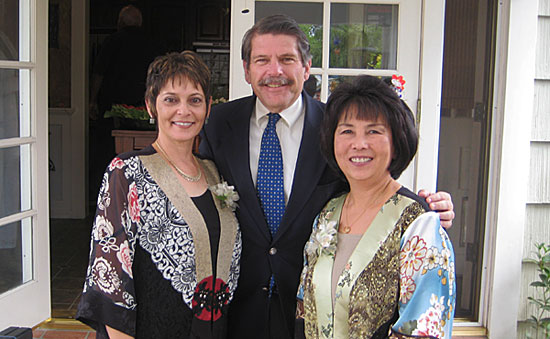
In October 2008, Supervisor Yaroslavsky officiated at the marriage of Rita Romero, left, and June Lagmay.
During my many years in public life, there’ve been just a handful of times when I’ve been caught off guard.
This week, as the U.S. Supreme Court heard arguments on the constitutionality of California’s voter-imposed ban on same-sex marriage, I thought back to one of those surprising—and humbling—moments. It came some two decades ago when, as chairman of the Los Angeles City Council’s finance committee, I championed a measure to provide domestic-partner benefits to couples who’d been living together for more than a year.
After the vote, the committee’s clerk asked whether she might speak with me for a moment. By then, the hearing room at City Hall had cleared. It was just the two of us. I figured she had some committee business to discuss. And, in a very deep and unexpected sense, she did. She revealed that she’d been living with a partner, a woman, for nearly 20 years. “I just want you to know,” she said, “that this legislation will improve the quality of our lives in a truly meaningful way. Thank you.” I was overwhelmed. It’s rare that you get to witness such an immediate and profound impact of a vote on a person’s life. That was a good day.
Throughout my career, I’ve worked hard to be a consistent advocate for groups and individuals marginalized by society, including gays and lesbians. From my earliest days on the City Council, I confronted the Los Angeles Police Department for wrongly harassing gays and lesbians. I was the first straight elected official in California to debate then-State Senator John Briggs over his infamous (and doomed) ballot initiative in 1978 that would have prohibited gays and lesbians from teaching in the public schools, a measure ultimately opposed by Ronald Reagan.
But until a decade ago, I didn’t embrace the movement for same-sex marriage. I didn’t see the point. Hadn’t we provided gay and lesbian couples with virtually all the benefits of marriage except a license? With so many other important fights to pick, was this among the most pressing struggles for our society’s well-being?
Then I got educated. I had a conversation with my daughter, one that reminded me of that old Crosby, Stills, Nash & Young song, “Teach Your Children.” In the final refrain, it calls out to the young listeners of the day to “teach your parents well.” And in my home, like millions of others across America, that’s what happened.
“What difference does it make to you, Dad, if same-sex couples want to get married?” asked my daughter, who was then in her 20s. Although it was a simple question, I couldn’t summon a satisfactory answer no matter how hard I tried. The core issue was no different than any other civil rights struggle: a right extended by government to some was being denied to others solely because of sexual orientation, putting it in the same class as other discrimination battles our nation has known all too well.
While some people have described their support of marriage equality as an evolution, it was more like a 180-degree revolution for me after that conversation with my daughter. In the ensuing decade, I’ve supported same-sex marriage and I campaigned against Proposition 8, the California ballot measure now before the Supreme Court.
I’m hoping that the justices go big, that they rule as unconstitutional any laws banning same-sex marriage anywhere in the country. Judging from their questions and observations from the bench this week, most experts think that’s unlikely. Still, I’m keeping my fingers crossed that the court will at least begin to get on the right side of history and strike down California’s Proposition 8, which enshrined discrimination in the state’s constitution.
Maybe if each justice had the chance to preside over a same-sex union, as I have, they’d have a better sense of why Americans increasingly favor marriage equality.
In the fall of 2008, during a five-month window when such marriages were legal in California, I was honored to be asked by June Lagmay and Rita Romero to officiate at their wedding. June was no longer the clerk for the City Council’s finance committee, as she was when we had that private chat in the hearing room so many years ago. She’s now the City Clerk for the City of Los Angeles, and she’d waited a long time to wed her partner of 40 years, a wait that had joyously ended when the California State Supreme Court ruled for marriage equality.
The couple’s home in Temple City was packed with friends and family. There were beautiful rings, champagne toasts and a big layered cake. But most of all there was love, the kind that’s full of understanding and acceptance, a love that’s too powerful to be contained by bigotry and bad laws.
Posted 3/27/13
Expo 2’s ahead of the curve
February 7, 2013
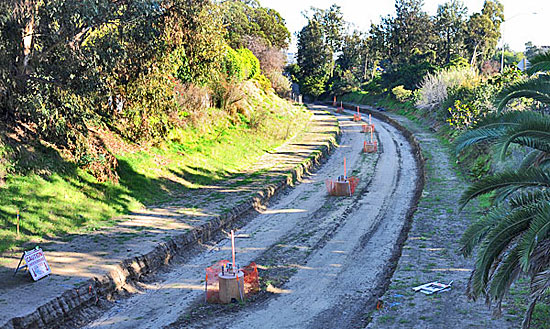
The Northvale Trench in Cheviot Hills, where Expo trains will run along a path blazed by their rail predecessors.
Maps and blueprints are fine, but there’s nothing like getting out into the real world and seeing the future take shape.
A few days ago, I had the opportunity to tour the second phase of the Expo Line, which is rapidly taking form along a corridor running from Culver City to Santa Monica.
It was remarkable. New bridges are rising, a once-abandoned railroad right-of-way is coming back to life and the contours of the project are emerging before our eyes.
The thrill of going behind the scenes in the construction zone was kind of like seeing a prenatal sonogram: Expo Phase 2 is still a long way from the delivery room, but this baby’s shaping up beautifully.
When the 6.6 mile stretch is finished in 2015—with a final station just a short walk from the Pacific Ocean—it will complete the light rail line that’s now carrying more than 23,000 passengers a day between downtown Los Angeles and Culver City. It will offer a true alternative to the heavily congested Santa Monica Freeway that it parallels for much of its route.
And it will mark another crowning achievement in what I consider the golden era of public transportation infrastructure development in the Los Angeles region.
Think about it: in just the last 10 to 15 years, we’ve built a subway to the San Fernando Valley, forged light rail connections to Pasadena, East Los Angeles and Culver City, and created two legs of the Orange Line rapid transit busway that now runs from North Hollywood to Chatsworth. Workers currently are constructing a new stretch of the Gold Line from Pasadena to Azusa, and work should be starting on the Crenshaw Line to LAX in the not-too-distant future. We’re also preparing to extend the subway to the Westwood V.A. and to build a Regional Connector downtown to help tie it all together.
As we’ve grown the system, the whole has proven to be much bigger than the sum of its parts, offering a bustling network of region-wide connections that would have been unthinkable a generation ago.
In our notoriously sprawling and supposedly car-dependent region, we’ve shown that Angelenos aren’t wedded to their automobiles and in fact are more than willing to vote with their feet if we can offer alternatives to an increasingly clogged freeway system.
I fully expect them to beat a path to the Expo Line when it’s complete. I’m not just talking about folks who live on the Westside but also the thousands throughout the region who commute there for jobs and recreation.
From what I saw during my tour, it’s clear that this line will offer them more than just a great escape from traffic on the 10. It also will provide a bargain tour of Los Angeles rarely glimpsed through the windshield of a car. It includes a sylvan stretch in Cheviot Hills where the Red Car once ran, panoramic views from bridges and elevated platforms along the route, and a middle-of-the-street trip through the pleasant urbanscape of Colorado Boulevard before it concludes at 4th Street and Colorado, just across from Santa Monica Place and down the street from the Pier.
Construction projects, of course, are highly unpredictable but I’m happy to report that this one, for now, is on time and on budget—maybe even a little ahead of the game.
But we can’t afford to let up.
Funding for Expo Phase 2 and other projects comes from Measure R, the ½-cent sales approved by 68% of county voters in 2008. Disappointingly, efforts to extend the sales tax for another 30 years—making it possible to get moving sooner on an array of transportation projects—failed at the ballot box this past November.
The extension, known as Measure J, lost even though it received 66.11% of the vote because of an anachronistic provision in our state constitution requiring two-thirds voter approval for such measures.
This needs to change.
So as construction teams work to finish Expo, efforts are building in Sacramento to try to move the approval threshold from two-thirds to a still-difficult but more reasonable 55%.
I hope that the state’s voters are ready for the change, and for the improvements in transportation infrastructure it could generate.
Because here in Los Angeles, we’re building a transit system that will benefit our region for generations. And we have no intention of turning this train around now.
Posted 2/7/13
Stan the Man and an L.A. boy
January 24, 2013
“I’d like to talk to Stan Musial.”
I was a baseball-crazed 11-year-old when I made that pronouncement to the telephone operator at the old Hotel Statler at Wilshire and Figueroa. I’d learned from a feature in the Sporting News that the St. Louis Cardinals were staying there during a series with the Dodgers—and I was determined to talk to Stan the Man, the visiting team’s star outfielder.
The nickname was spot-on. During a career spanning more than two decades, Musial would ultimately win seven batting titles, appear in 24 All-Star Games and set scores of records. He was that rare player who was elected to the Hall of Fame on the first ballot. Still, despite the gaudy numbers, he was also known as a humble gentleman, with little of the flash of such famous contemporaries as DiMaggio, Mantle and Mays. Musial spoke softly but carried a very big stick.
So I guess I shouldn’t have been surprised when he picked up the phone in his hotel room. But I was. He caught me off guard in my ruse as a radio sportscaster named Bob Price. (I didn’t think he’d bite on a name like Zev Yaroslavsky.) Trying my best to sound older than my pre-teen years, I asked a series of questions about the team’s strengths. He thoughtfully answered each, offering particular praise for a young right-handed pitcher named Bob Gibson, who’d one day join him in Cooperstown. Because I didn’t expect to actually talk to Musial, I quickly exhausted my list of questions.
I closed the “interview” by melodically saying, “Thank you, Stan Musial, for being on our sports show.” To which he said: “You’re welcome, son.” Turns out, he’d been playing along from the start, so free of self-importance that he was willing to take a few moments to give a kid a memory of a lifetime. Imagine that.
Last Saturday, at the age of 92, Stan Musial passed away, and that memory from the late 1950s came back to me with the power of one of his mighty swings. I know that, given the security concerns of today, such a phone conversation between a boy and a ballplayer would be highly unlikely. But I also wonder how many of our super-star athletes even recognize, as Musial did, the obligations that come with fame. Celebrity is not an entitlement. Forgive the cliché, but whether in sports or politics, you’ve got a responsibility to be a role model for those who look up to you.
Two years ago, this quality in Musial was recognized in a White House ceremony by President Obama, who presented him with the nation’s highest civilian award, the Medal of Freedom. Obama described Musial as “untarnished, a beloved pillar of the community, a gentleman you’d want your kids to emulate.” For my part, I’ve given it my best.
Sometimes, when I get a late-night call from a constituent with a problem—and they’re not play-acting—I think back to that day when Musial found time to talk to a young kid. And then I try to step up to the plate, too. Now 64, I’ll be forever grateful to the ballplayer who demonstrated what being a man is really about.
Posted 1/24/13
A legacy of California gold
January 10, 2013
The obituaries told us that he’d been a fixture on local television since the early 1980s, but I could have sworn that Huell Howser had been a part of our family for a lifetime. It felt like I’d been a fan of his for that long. When Huell generously agreed to preside over my swearing-in as a newly-minted County Supervisor in 1994, it was one of the high points of my political career.
Huell came from sturdy American stock. He was born in Gallatin, Tennessee, established in 1802 as the county seat of Sumner County and named for Albert Gallatin, a Secretary of the Treasury under Presidents Thomas Jefferson and James Madison. Maybe it was that kind of rich history and sense of place you find in so many Southern towns that helped develop this country boy into the gifted storyteller that enchanted the city slickers here in Los Angeles for so many years.
Huell and I shared a deep fascination with history in our college studies, and he earned his undergraduate degree in it from the University of Tennessee in Knoxville. After a stint in the Marine Corps and serving on the staff of Sen. Howard Baker—one of my Watergate heroes—he embarked on a career in TV news, working locally in Nashville before graduating to New York.
In 1981, he came to Los Angeles as a feature reporter for KCBS-TV, but soon found that the hustle of local TV news and its obsession with crime and celebrity fluff wasn’t his thing. In 1985, he found a happier home at KCET, then the Southern California flagship station for PBS. There he created a wide variety of feature programs like Videolog, California’s Gold and others, and finally hit his stride as a joyful chronicler of all things California, from quirky people and offbeat occupations to spectacular natural wonders and all manner of outdoor adventures.
With his shades, Hawaiian shirts, shorts or khakis, he was like a slightly goofy tour guide for a statewide vacation that never ended. There was nowhere he wouldn’t go, nobody he wouldn’t talk to. He was always friendly, cheerful, courteous and somehow incredibly interested and excited to learn about the most obscure places, occupations or activities.
Everything was “amazing” to Huell—“Oh, my gosh! Would you look at that!” he would always exclaim. It’s been said many times, but I honestly think it was Huell’s sense of innocence and wonder that was the key to his enduring and universal appeal. It wasn’t an act. There was nothing cynical, ironic or post-modern about it. This wasn’t the “Daily Show.” Off-camera—and I know, since we were friends and practically neighbors when he was staying at the grand old El Royale Apartments on Rossmore—he was exactly the same earnest and charming guy that you saw on screen.
Huell may have been born in Tennessee, near the cradle of the Confederacy, but he became by choice an adopted son of the Golden West. Maybe that’s why he had so much respect and admiration for the wonderful things too many of us native Californians take for granted.
It was easy to make fun of his folksy, “gee-whiz” manner, but you just had to spend five minutes with him to know that it was no put-on. His segments were just as honest and straightforward, strictly do-it-yourself productions—Huell and a camera guy, basically—but who needed all the other bells and whistles? The classic storytellers of ancient times required only a campfire, an audience, and a story to tell.
Though he became a genuine TV star, he never lost his modesty or humility. As he was winding down his career, he donated his tapes, books, and even his spectacular Volcano House home in the desert to Chapman University. Nearing the end, he instructed his colleagues that he wanted no ceremony or memorial, public or private, and he asked close friends to honor his wishes that they not participate. He just wanted people to watch his shows and enjoy the stories. That’s the only tribute he wanted.
When we first learned of his retirement in November, we hoped to honor him at the Board of Supervisors. We couldn’t have known at that time that he was already too ill to participate.
Now he’s gone, and it feels like we’ve all lost a cherished friend. So let me just say: “Happy trails, Huell.” You’ve left behind a wonderful legacy.
Posted 1/10/13




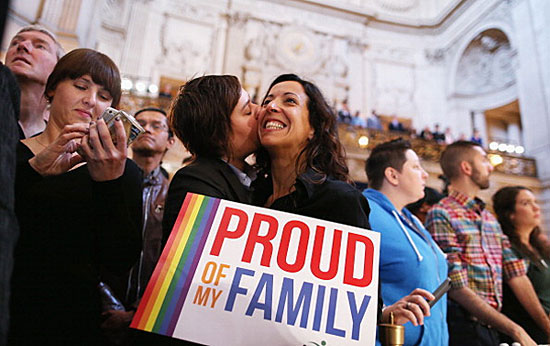
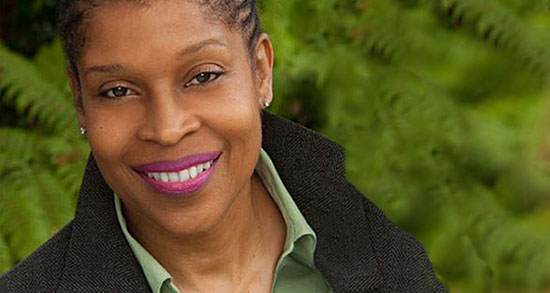
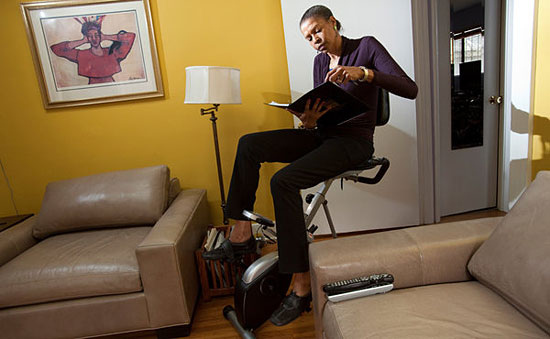
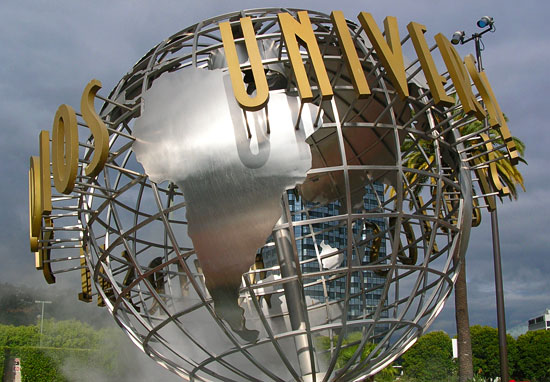
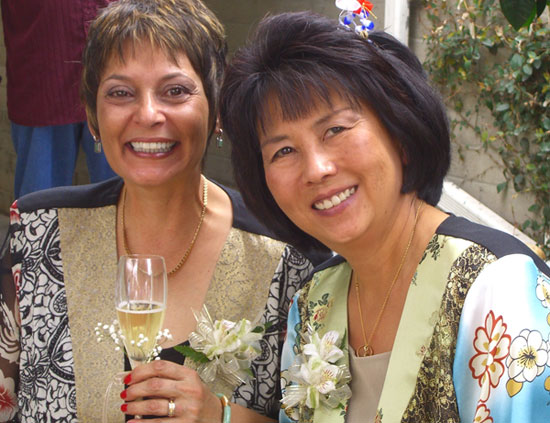
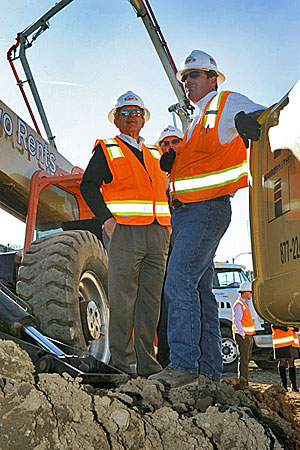
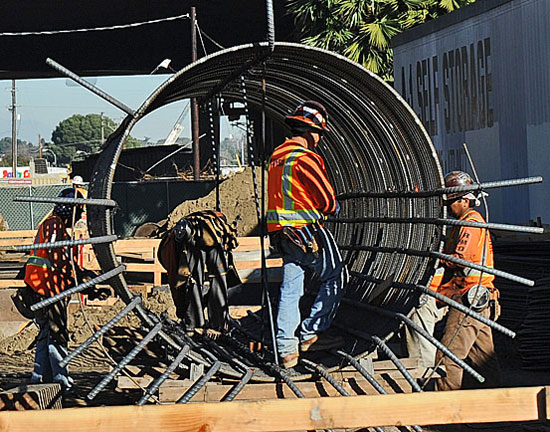
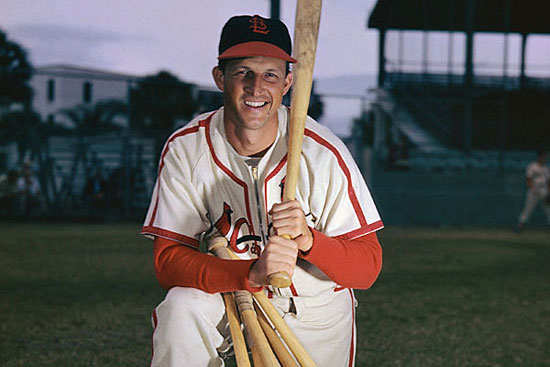
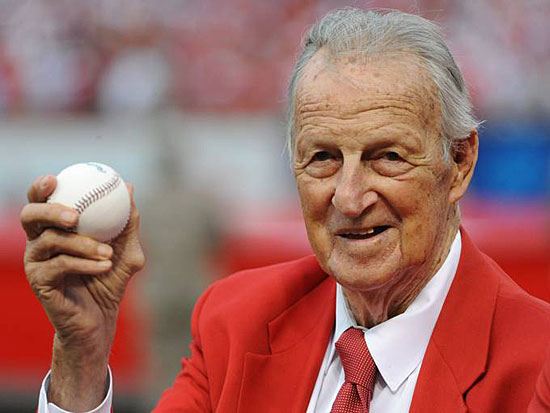
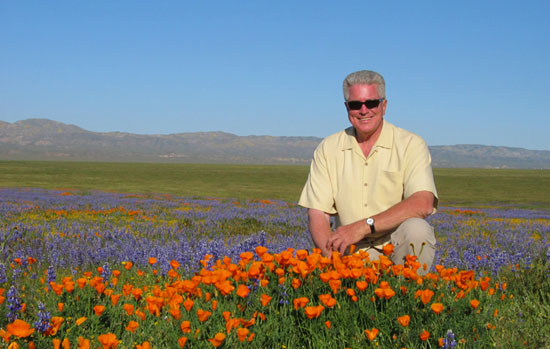





 Check for the latest closure information
Check for the latest closure information








